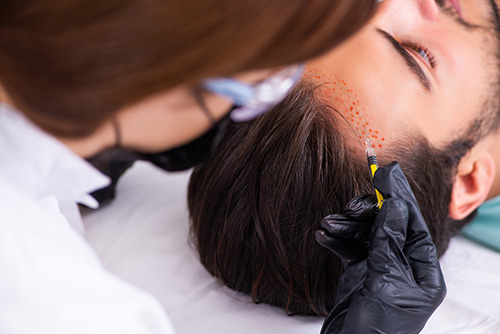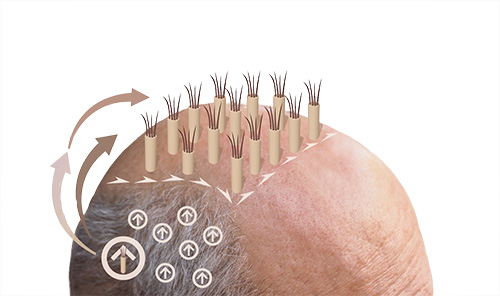Hair Transplantation in Turkey Cost and Details

- What is a Hair Transplant?
- Hair Transplantation Cost in Turkey
- Hair Transplantation Methods
- How Hair Transplantation is Performed?
- After Hair Transplant
- Hair Transplant Risks
- When to get a hair transplant?
- Minimum Age for Hair Transplant
What is a Hair Transplant?
By definition, a hair transplant is the process of moving hair from one part of the body to another. A hair transplant is only possible with your own hair. The reason some people consider and have a hair transplant done is hair loss in most cases. A person can lose up to 100 hairs a day without this being unusual. However, some people lose significantly more hair.
The most common types of hair loss are:
- Hereditary hormonal hair loss (alopecia androgenetica)
- Circular hair loss (alopecia areata)
- Reactive hair loss (also called diffuse hair loss)
In a hair transplant, the hair follicles are transplanted from one part of the body to another. The hair follicles are the structures that enclose the hair roots in the skin and in which the hair grows. So healthy hair follicles are taken from a place where the hair is not thinning or falling out. In order not to just rely on their sense of proportion, doctors often measure hair density and hair mass here. Often this is a spot at the back of the head. Sometimes it can also be hair follicles that do not come from the head, but from the chest or back.

A hair transplant, whether for women or men, usually proceeds in the following three steps:
- Removal of the hair follicles
- Interim storage
- Insertion of the hair follicles
Hair Transplantation Cost in Turkey
The cost of a hair transplant depends on how much hair the doctor transplants from one place to another. The price is usually between 2,000 and 10,000 euros. It usually doesn't matter whether the hair transplant is a receding hairline or the back of the head.In some cases, health insurance companies cover the cost of a hair transplant – or at least part of it. This can be the case if the person concerned is proven to be suffering from hair loss and a psychiatrist certifies this.
Hair Transplantation Methods
All hair transplant methods have in common that hair follicles are taken from a healthy area and transplanted to a bald area. Different methods differ in how the hair is taken from the donor area.
Usually, the doctor first removes small areas of skin with a few hairs. Doctors call these mini transplants grafts. If a graft consists of 4-6 hairs, doctors speak of a mini-graft. If it is only 1-3 hairs, they say micro-graft.
- Hair transplantation with FUE: The most common method today to remove such grafts is FUE hair transplantation. The grafts are removed as small islands. In some cases, hair transplantation can even be done without shaving. There are already robots that can perform hair transplants. These usually also use the FUE method.
- Hair transplantation with FUT: The strip method, also known as the FUT method, is a little older than the FUE hair transplantation. The grafts are cut out as small strips.
- Punch method: Doctors punch a small area of skin from the donor area and implant it at the target site. Not infrequently, however, this led to an unsightly scar.
How Hair Transplantation is Performed?
Before the actual hair transplant takes place, the process begins with a doctor-patient discussion and an initial examination. The doctor tests the type of hair loss (such as circular hair loss, reactive hair loss or hereditary hormonal hair loss) in the person concerned and asks questions about other cases of hair loss in the family. The doctor then discusses with the patient which surgical method he would like to use and explains why. He also mentions the exact costs of the procedure.
To determine the type of hair loss, there are various examination methods:
- Pluck test: The doctor pulls out individual hairs and checks how tight they are.
- Scalp biopsy: The doctor removes a small piece of scalp under local anesthesia for further analysis.
- Tricho-Scan: The doctor determines the ratio of growing to atrophied hair.
- Trichogram: The doctor pulls some hair from the patient and microscopically examines its root.
- Hormone analysis: The doctor examines the hormonal status of the person concerned and can thus check whether this can be the cause of the hair loss.
After Hair Transplant
A pressure bandage is left on the hair transplant site for a few days, usually three to four. The doctor then takes it off. Crusts may form on the transplant sites and also in the donor area after the procedure, but they will fall off after a few days. Once this has happened, the patient can take care of his hair again and wash it with shampoo. Swelling can sometimes occur, but this usually disappears on its own.
It takes a few months for the first results to appear. Initially, hair loss can even occur after a hair transplant. However, this is completely normal and nothing to worry about. The growth of the new, correct hair begins about three months after the procedure.
Hair Transplant Risks
The side effects of a hair transplant are minimal, and doctors consider the surgery to be harmless. During the procedure, the treated person does not feel any pain because the doctor locally anesthetizes the transplant sites.When this anesthesia wears off, you may experience slight pain for a day or two. Also, the affected area may swell slightly and feel numb or tense. Minor bleeding is rare, but it usually stops on its own. Infections occur in less than 1 in 1000 cases.
When to get a hair transplant?

A hair transplant can be an option in many situations and for many reasons. For example for people with a bald head, but also for people with unpopular receding hairline or a high forehead. A hair transplant can also help people who have developed a kind of tonsure due to patchy hair loss.
The hair does not always have to be implanted on the head either. There is also the possibility of a beard hair transplant. In addition to a beard, doctors can also transplant eyelashes or eyebrows.
There are also some prerequisites that should be clarified first. On the one hand, this is the cause of hair loss. In the case of genetic hair loss, for example, the chances of success are better than in the case of diffuse hair loss. A family history taken by the doctor can also help assess the success rate. The respective doctor then informs about possible medical restrictions that would prohibit a hair transplant.
Minimum Age for Hair Transplant

Another requirement for hair transplantation is age. The minimum age for plastic surgery such as hair transplantation is 18 years. In fact, there are people with hereditary hair loss whose hair is already receding at this age. However, many doctors still recommend waiting a few more years before having a hair transplant – usually until the age of 25. They do this because sometimes it's hard to predict where more hair will fall out, which could result in patches after a hair transplant.
There are no comments yet. Would you like to add a comment?
In accordance with Article 10 of the Personal Data Protection Law (PDPL,KVKK) titled Data Controller's Obligation to Disclose, we use cookies in accordance with the legislation, limited to the purposes specified in the privacy policy.

